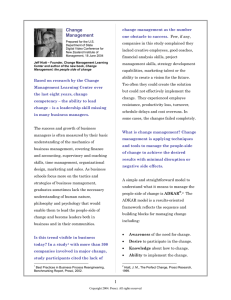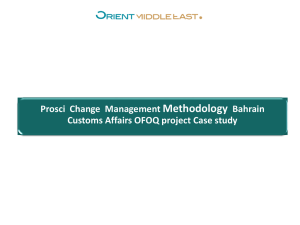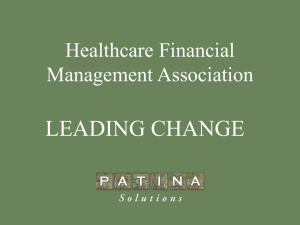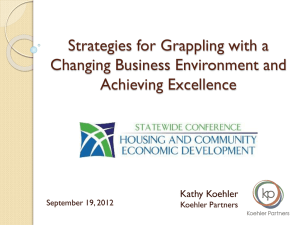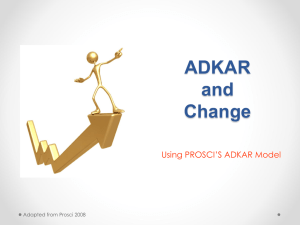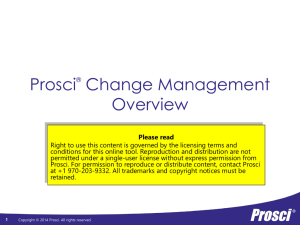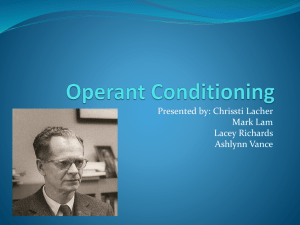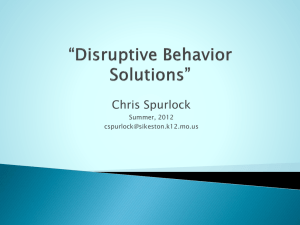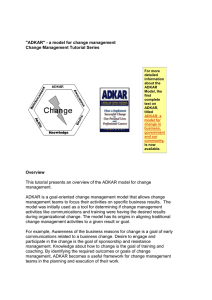Enhancing your Organizational Effectiveness
advertisement
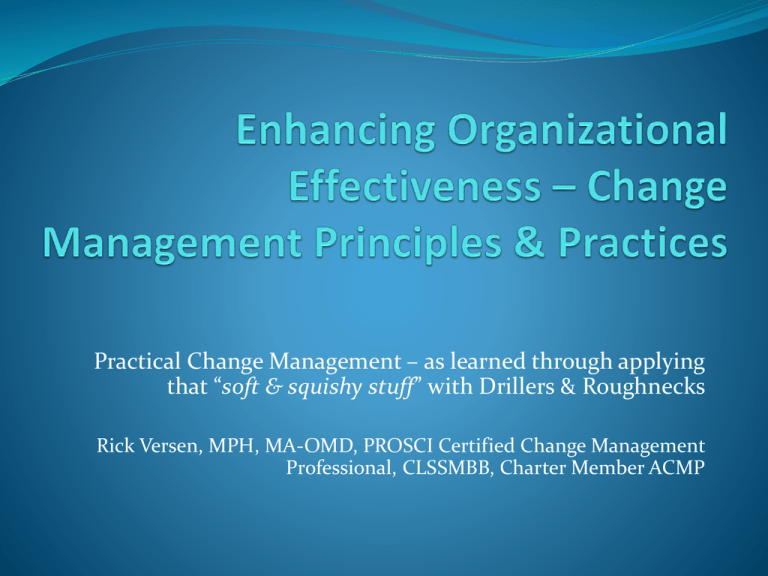
Practical Change Management – as learned through applying that “soft & squishy stuff” with Drillers & Roughnecks Rick Versen, MPH, MA-OMD, PROSCI Certified Change Management Professional, CLSSMBB, Charter Member ACMP Future Oriented Information In the interest of providing Encana Corporation (“Encana” or the “Company”) shareholders and potential investors with information regarding the Company, its subsidiaries, including management’s assessment of the Company’s future plans and operations, certain statements and graphs throughout these presentations contain “forward-looking statements” within the meaning of the United States Private Securities Litigation Reform Act of 1995 or “forward-looking information” within the meaning of applicable Canadian securities legislation. Forwardlooking statements in this presentation include, but are not limited to: possible applications of the Lean Six Sigma processes within E&P processes; projected number of improvement projects/events that could use LEAN; and the various possible applications of LEAN in the Company’s operations and processes. Readers are cautioned not to place undue reliance on forward-looking statements, as there can be no assurance that the future circumstances, outcomes or results anticipated in or implied by such forward-looking statements will occur or that plans, intentions or expectations upon which the forward-looking statements are based will occur. By their nature, forward-looking statements involve numerous assumptions, known and unknown risks and uncertainties, both general and specific, that contribute to the possibility that circumstances, events or outcomes anticipated or implied by forward-looking statements will not occur, which may cause the actual performance and financial results in future periods to differ materially from the performance or results anticipated or implied by any such forward-looking statements. These assumptions, risks and uncertainties include, among other things: risks associated with the ability to obtain any necessary approvals, waivers, consents, court orders and other requirements necessary or desirable to permit or facilitate the proposed transaction (including regulatory and shareholder approvals); the risk that any applicable conditions of the proposed transaction may not be satisfied; volatility of and assumptions regarding oil and gas prices; assumptions contained in or relevant to the company’s current corporate guidance; fluctuations in currency and interest rates; product supply and demand; market competition; risks inherent in marketing operations (including credit risks); imprecision of reserves estimates and estimates of recoverable quantities of oil, bitumen, natural gas and liquids from resource plays and other sources not currently classified as proved reserves; refining and marketing margins; potential disruption or unexpected technical difficulties in developing new products and manufacturing processes; potential failure of new products to achieve acceptance in the market; risks associated with technology; the ability to replace and expand oil and gas reserves; the ability to generate sufficient cash flow from operations to meet current and future obligations; the ability to access external sources of debt and equity capital; the timing and the costs of well and pipeline construction; the ability to secure adequate product transportation; changes in royalty, tax, environmental and other laws or regulations or the interpretations of such laws or regulations; applicable political and economic conditions; the risk of war, hostilities, civil insurrection, political instability and terrorist threats; risks associated with existing and potential future lawsuits and regulatory actions; and other risks and uncertainties described from time to time in the reports and filings made with securities regulatory authorities by Encana. Although Encana believes that the expectations represented by such forward-looking statements are reasonable, there can be no assurance that such expectations will prove to be correct. Readers are cautioned that the foregoing list of important factors is not exhaustive. Furthermore, the forward-looking statements contained in this presentation are made as of the date of this presentation, and, except as required by law, Encana does not undertake any obligation to update publicly or to revise any of the included forward-looking statements, whether as a result of new information, future events or otherwise. The forward-looking statements contained in this presentation are expressly qualified by this cautionary statement. What that really means… I’m just a low level flunky Don’t go out and buy, sell, or even talk about the company based on what I say Seriously, don’t think I know more than I know These are my thoughts and aspirations I invoke the Tooter the Turtle Philosophy: “Be just what you is, not what you is not. Folks what does this is the happier lot.” M. Wizard AFDO/WAFDO/FDA/RMRAS “Food, Feed, Drug Safety – Mission Critical – Working Together” Learning Objectives: Explore change management fundamentals & concepts Practical application for each participant Your World? Consumer Protection Body Art Food Worker Behavior My World - The People Petroleum engineer The Environment Our Factory!?! “Dirty Oil” “Clean solar” NIMBY “Fracing” “Cracking the technical nut” Social License to operate Oodles & Oodles of Models & Models Lewin Bridges Kotter Jick PROSCI Lawler & Worley Heath & Heath Peter Block GE CAP Peter Sandman Risk = ƒ(Hazard x Outrage) Sidebar on that “Valley of Despair” thing Most folks grasp the concept & the impact readiness, agility, saturation, and (fill in your favorite buzzword…) can have on the “Amplitude” of the valley… But, the more important concept for large scale change is…. “Phase Shift” Everyone not at same pace Don’t learn at same rate Don’t have same level of visibility Even related to level in organization WIFFM is different Example 1… Challenge: What is the fastest way to drill through X formation? 3 different Drilling Bosses – 3 different approaches Technical Solution: DOE (Design of Experiment) 3 factor, 2 level orthogonal Full Factorial Design What about the Softer Solution: Making it stick? Engage all 3 in developing & running the tests “On location” work – not office Develop implementation plan with the bosses Include metrics going forward Encourage competition between the teams Example 2… Challenge: Increase collaboration & knowledge sharing in a culture that already collaborates and shares knowledge Technical solution: Newsgator/Spoint platform for real-time problem solving & knowledge transfer The Softer (Harder?) Solution: Multiple benchmarking studies Multiple Consultant pitches – to verify internal strategies SNA & VNA, Case Studies, Connector training, etc., etc., etc. (My Master’s thesis!!!) Launch, crickets…re-launch, crickets… Help Mr. Wizard!!! A moment on “SNA” Social Network Analysis Finding influencers & connectors Statistical basis Simpler tools available Helps target interventions So do you hear “Crickets?” Most of us have experience with change management at some level Personal – lifestyle – “Krispy Kreme Konundrum” Career – new bosses, new regs, new stakeholders Bottom line – moving people from bad behaviors/ processes/ risks/ food etc. toward a better/ safer/ healthier alternative So what’s a humble practitioner supposed to do?? Leverage! Adapt Experiment Standardize Best Practices in Change Management, 2014 Edition, PROSCI How do we do this? The ADKAR Model Awareness Desire Knowledge Ability Reinforcement of the need for change to participate and support the change on how to change to implement required skills and A behaviors to sustain the change © Prosci 2008 D K A R Example ADKAR Assessment Multiple stakeholders Amplitude? Phase shift? Diagnostic tool 16 Without ADKAR In the absence of: You will see: Knowledge and • • • • • • • Ability • Reinforcement • • • • • Awareness and Desire More resistance from employees. Employees asking the same questions over and over. Lower productivity. Higher turnover. Hoarding of resources and information. Delays in implementation. Lower utilization or incorrect usage of new processes, systems and tools. Employees worry if they are prepared to be successful in future state. Greater impact on customers and partners. Sustained reduction in productivity. Employees will revert back to old ways of doing work. Ultimate utilization is less than anticipated. The organization creates a history of poorly managed change. © Prosci 2008 The ADKAR Model Awareness of the need for change. What is the nature of the change? Why is the change happening? What is the risk of not changing? Who delivers the message? Awareness Desire Knowledge Ability Reinforcement © Prosci 2008 Importance of Matching Message & Sender For business & strategy messages – Executives For “WIIFM” – my Supervisor! What about the general public? Source: PROSCI 2013 Best Practices research 19 The ADKAR Model Desire to support the change. Personal motivation to support the change Organizational drivers to support the change Where’s the WIIFM? Awareness Desire Knowledge Ability Reinforcement © Prosci 2008 The ADKAR Model Knowledge on how to change. Knowledge, skills and behaviors required during and after the change Understanding how to change Awareness Desire Knowledge Ability Reinforcement © Prosci 2008 The ADKAR Model Ability to implement new skills. Demonstrated ability to implement the change Barriers that may inhibit implementing the change Cultural? Intellectual? Awareness Desire Knowledge Ability Reinforcement © Prosci 2008 The ADKAR Model Reinforcement to sustain the change. Mechanisms to keep the change in place Recognition, rewards, incentives, successes Awareness Desire Knowledge Ability Reinforcement © Prosci 2008 Greatest Contributors to Success 1. Active & visible executive sponsorship 2. Structured approach to managing change 3. Dedicated change management resources 4. Frequent & open communication about the change and the need for the change 5. Employee engagement & participation 6. Engagement & integration with project management 7. Engagement with & support from middle management Source: PROSCI 2013 Best Practices research 24 Resistance: most common reasons managers resist change 1. 2. 3. 4. 5. Fear of losing control and authority Lack of time Comfort with the status quo No answer to “What’s in it for me?” No involvement in solution design [What about your stakeholders?] Factors Influencing Awareness Factor 1 – A person’s view of the current state Denial - If it’s not broke – don’t fix it! I told you that needed to be fixed a long time ago Factor 2 - How a person perceives problems Adaptive and aware of internal threats? How we internalize and approach warnings Factor 3 – The credibility of the sender Who delivers the message is as critical as the message Why the change from Execs; How the change by supervisors Factor 4 – Circulation of misinformation & rumors What is real & what is fabricated? What analogies to other attempts at change can influence this one? Factor 5 – Contestability of the reasons for change Are their external or internal reasons for doubt? Is it debatable about the need for the change Factors Influencing Desire Factor 1 – The nature of the change and WIIFM • What “it” is, is important, what it means for me is more important! Factor 2 – Organizational or environmental context • • Past changes, Org. history, can some opt out? Will vary from person to person Factor 3 – An individual’s personal situation • • Family & personal life factors influence Desire Each person has a unique capacity for change Factor 4 – Intrinsic Motivation • • Desire to help make things better? Desire for power? Respect? Position? Attachment Impacts Desire Identifying the “attachments” that people have can help find leverage points around how to move them forward 28 Factors Influencing Knowledge Factor 1 – The current knowledge base of the individual • • Is “the knowledge” already present? What is the gap between current and future needs? How big? Factor 2 – The capacity or capability of the person • • Can the person actually perform the new tasks? One size fits all training might not work across the board Factor 3 – Resources available for education/training • • Can we provide the resources to direct the training? What job aids can be created to simplify actions required? Factor 4 – Access to, or existence of, the required knowledge • • Do we have the expertise? What would this do to our project timeline? Factors Influencing Ability Factor 1 – Psychological blocks • • Is there an inherent fear within the individual that will block ability? Public speaking – most people fear it more than death! Factor 2 – Physical ability • • Are there limitations that will have to be addressed? Strength? Dexterity? Factor 3 – Intellectual capability • • Is there a disconnect between current state requirements and future? Will there be technological or learning related problems? Factor 4 – Time available to develop skills • • Even if the person has the potential to adapt – do we have the time? What external factors drive the implementation schedule? Factor 5 – Availability of resources • Is there support during the developmental period – financial, tools, coaching, access to SME/Experts? Factors Influencing Reinforcement Factor 1 – Meaningful • Recognition/reward/punishment has to mean something at the individual level Factor 2 – Association with the actual accomplishment • • Can we celebrate small successes? Key metrics need to be established Factor 3 – Absence of negative consequences • • Need to clarify expectations for non-conformance Peer pressure can be good or bad Factor 4 – Accountability systems • • • Performance management systems Individual – Boss/Subordinate, Peer/Peer, Mentee/Mentor Recognition & continual reinforcement How to reinforce the behaviors… In contrast to the big strategy messages from Executive Leaders… Individuals want their direct supervisor to engage on what they do to change behaviors Source: PROSCI 2013 Best Practices research 32 Peer Pressure – another lever Influence – producing an effect in another person without apparent exertion of force Peers exert a type of influence that leverages the promise of acceptance Social pressure by members of one’s peer group to take a certain action, adopt certain behaviors, or otherwise conform in order to be accepted Identify “who are the cool kids?” What are the characteristics of those with informal influence? 33 Sponsor Engagement Biggest Mistakes 1. Failed to remain visible & engaged throughout the process 2. Failed to demonstrate support in words & actions 3. Failed to effectively communicate messages 4. Ignored the people side of the change 5. Delegated or abdicated the sponsorship role & responsibilities Effective Tactics 1. Provide behind-the-scenes assistance to Sponsors 2. Coach the Sponsor on their role 3. Hold regular meetings with Sponsor(s) 4. Ensure Sponsor communicates directly with employees 5. Hold Sponsor accountable for their role Source: PROSCI 2013 Best Practices research 34 The Soft stuff is the Hard Stuff!! Moving people from here to there is tough! Even when they know “here” is bad! Change Management is more than a simple communications plan Actively involving stakeholders at the right time, with the right information, with the right intent is critical There are processes & tools that help identify the key levers & constraints You can learn how to lead change!
